How to keep your lawn looking its best through winter
How to keep your lawn looking its best through winter
Winter isn’t an easy season for lawns. Between soggy soil, freezing temperatures, sudden snow showers and a general lack of sunshine, grass has a lot to cope with. The good news? With a few small habits, you can help your lawn stay healthy so it bounces back beautifully in spring.
Here’s how to give your grass the TLC it needs during the colder months.
When your lawn is wet, tread carefully
Winter rain can leave your grass sitting on waterlogged soil. When this happens, the main rule is simple: keep off as much as you can.
Wet soil compacts easily, and compacted soil means unhappy grass roots. If you need to walk across a soggy lawn, try sticking to the same path each time so the compaction is limited to one small area. A pair of stepping stones or planks can help if it’s a route you often use, for example to your bird table or log store.
If the lawn is prone to staying boggy, lightly spiking it with a garden fork can improve drainage. But only do this when the soil isn’t too sloppy, or you’ll just make more mess.
Frosty mornings, keep off the grass
Frost might look pretty, but it’s tough on turf. Frozen grass blades become brittle, so walking on a frosty lawn can crush them, leaving brown tracks that linger long after the thaw. The best approach is to enjoy the sparkle from a distance and avoid any foot traffic if you can, until the frost melts.
The same rule applies to mowing. In winter, mowing is rarely needed anyway but absolutely avoid it if the grass is frozen or very wet. You’d be surprised that some people do attempt this!
Snowfall? Don’t panic
A layer of snow actually acts as a gentle insulator, protecting your lawn from harsh winds. The problem usually comes afterwards, when snow is compacted into icy paths by footsteps.
If possible, avoid creating trails across snowy lawns, as these can cause the same damage as walking on frost. Once the snow melts, the grass should recover on its own.
The great leaf clean-up
A deep layer of leaves left to sit all winter create damp, dark conditions that encourage rot and moss. A quick weekly rake or leaf-blow during autumn and early winter helps keep things healthy. And remember that raked leaves make great compost.
If you aren’t fussed about having a perfectly tidy lawn, just remove the biggest leaf build-up and leave some, as they provide good cover for your garden wildlife.
Should you fix patchy areas now or later?
Winter isn’t the time to sow new seed as it’s simply too cold for germination. But you can prepare.
If you notice bare spots forming, gently clear away debris or thatch, and add to your spring to-do list. Once the weather warms, the ground will be ready for overseeding.
However, if the patches are large, you can actually still lay turf in the winter, unless the ground is frozen. For more information read our dedicated blog: Can you still lay turf in the winter? – HCT Turf
Under the bird feeder
Bird feeders are a great way of supporting our wild birds through the winter. However, the lawn underneath tends to suffer. Spilt seed, constant traffic, and scratching birds all add up to a muddy, bald patch.
You can reduce the damage by:
- Moving feeders occasionally so the wear spreads out
- Using trays or catchers to limit dropped food
- Placing a small gravel or bark mulched area under a hanging feeder
Or you can decide not to worry about it, enjoy watching the birds and then reseed or returf in spring.
A few extra winter lawn tips
Clear debris after storms. Fallen twigs and branches can smother small areas of grass if left for weeks.
Don’t feed your lawn in winter. High-nitrogen fertilisers encourage growth, which grass simply can’t sustain in cold weather.
Keep mower blades clean and sharpened and book your mower in for a service. This means you’ll be ready for that all-important first mow when conditions are right.
Watch out for moss. If moss is already creeping in, improved drainage and gentle autumn raking can help prevent a takeover.
Key points
- Keep off wet or frosty lawns to avoid stressing the grass
- Don’t worry too much about fixing bare patches unless there’s a major issue that needs urgent attention.
- A little regular clearing (leaves, debris, snow piles) keeps grass healthy and ready for warmer days.
We supply quality turf all year round. If you would like further advice on lawn care this autumn or would like to talk to us about your order, please contact us on 01392 231040 or email sales@wesellturf.com

